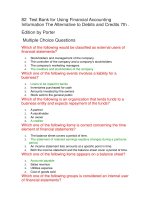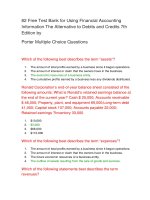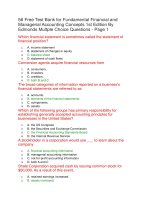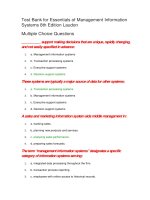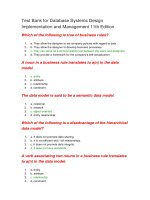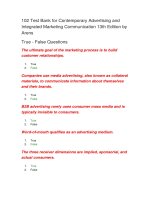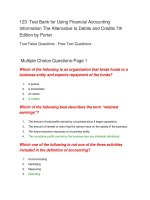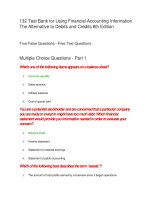Test bank for processes systems and information an introduction to MIS by kroenke
Bạn đang xem bản rút gọn của tài liệu. Xem và tải ngay bản đầy đủ của tài liệu tại đây (88.96 KB, 22 trang )
Full file at />
Processes, Systems, and Information (Kroenke/McKinney)
Chapter 1 Introduction to MIS
1) Moore's Law states that the number of transistors per square inch on an integrated chip
doubles every 18 months.
Answer: TRUE
Page Ref: 6
Difficulty: Easy
AACSB: Use of information technology
Chapter LO: 1
2) Moore's Law states that the speed of a computer doubles every 18 months.
Answer: FALSE
Page Ref: 6
Difficulty: Easy
AACSB: Use of information technology
Chapter LO: 1
3) As a result of Moore's Law, the ratio of price to performance of computers has increased
dramatically over the years.
Answer: FALSE
Page Ref: 6
Difficulty: Easy
AACSB: Use of information technology
Chapter LO: 1
4) The phenomenal growth of YouTube, Facebook, and Twitter are examples of how Moore's
Law can impact the business environment.
Answer: TRUE
Page Ref: 7
Difficulty: Moderate
AACSB: Use of information technology
Chapter LO: 1
5) Because of Moore's Law, any routine skill can and will be outsourced to the lowest bidder.
Answer: TRUE
Page Ref: 7
Difficulty: Easy
AACSB: Use of information technology
Chapter LO: 1
buy this full document at
Full file at />
6) Systems thinking is the ability to model the components of a system and to connect the inputs
and outputs among those components into a sensible whole, one that explains the phenomenon
observed.
Answer: TRUE
Page Ref: 8
Difficulty: Easy
Chapter LO: 1
7) An example of abstract reasoning skills is the ability to construct a model.
Answer: TRUE
Page Ref: 8
Difficulty: Easy
Chapter LO: 1
8) Critical feedback undermines collaboration.
Answer: FALSE
Page Ref: 9
Difficulty: Easy
Chapter LO: 1
9) Effective collaboration is all about being cordial to your team members.
Answer: FALSE
Page Ref: 9
Difficulty: Easy
Chapter LO: 1
10) Experimentation increases the fear of failure.
Answer: FALSE
Page Ref: 9
Difficulty: Easy
Chapter LO: 1
11) MIS is defined as the management and use of processes, information systems, and
information to help organizations achieve their strategies.
Answer: TRUE
Page Ref: 9
Difficulty: Easy
AACSB: Use of information technology
Chapter LO: 2
12) An information system is a collection of components, including a computer, that stores and
retrieves data and produces information.
Answer: TRUE
Page Ref: 10
Difficulty: Easy
AACSB: Use of information technology
Chapter LO: 2
13) Business processes are synonymous with information systems.
buy this full document at
Full file at />
Answer: FALSE
Page Ref: 10
Difficulty: Easy
AACSB: Use of information technology
Chapter LO: 2
14) A process may use multiple information systems and an information system may touch many
different processes.
Answer: TRUE
Page Ref: 10
Difficulty: Easy
AACSB: Use of information technology
Chapter LO: 2
15) Even if one is not technically qualified, one is still required to take an active role in
specifying process, system, and information requirements and in helping manage development
projects to create or adapt them.
Answer: TRUE
Page Ref: 10-11
Difficulty: Easy
AACSB: Use of information technology
Chapter LO: 2
16) MIS exists to help people who work in a business to achieve the strategies of that business.
Answer: TRUE
Page Ref: 11
Difficulty: Easy
AACSB: Use of information technology
Chapter LO: 2
17) Processes, systems, and information need to be created by a company to avoid falling behind
the technology curve.
Answer: FALSE
Page Ref: 11
Difficulty: Easy
AACSB: Use of information technology
Chapter LO: 2
18) The competitive strategy of an organization determines its value chain, which, in turn,
determines its business processes.
Answer: TRUE
Page Ref: 12
Difficulty: Easy
AACSB: Use of information technology
Chapter LO: 3
19) The assessment of each of Porter's five forces determines the characteristics of an industry,
how profitable it is, and how sustainable that profitability will be.
buy this full document at
Full file at />
Answer: TRUE
Page Ref: 12
Difficulty: Easy
Chapter LO: 4
20) Each of the three competitive forces in Porter's five forces model concerns the danger of
customers taking their business elsewhere.
Answer: TRUE
Page Ref: 13
Difficulty: Easy
Chapter LO: 4
21) The threat of a substitute is stronger if the substitute's price is higher and if the perceived
benefits of the substitute are similar.
Answer: FALSE
Page Ref: 13
Difficulty: Easy
Chapter LO: 4
22) An organization becomes a cost leader by providing products at the highest prices in the
industry.
Answer: FALSE
Page Ref: 14
Difficulty: Easy
Chapter LO: 5
23) An organization responds to the structure of its industry by choosing a competitive strategy.
Answer: TRUE
Page Ref: 14
Difficulty: Easy
Chapter LO: 5
24) An organization becomes a cost leader by focusing on adding value to its products to
differentiate them from those of the competition.
Answer: FALSE
Page Ref: 14
Difficulty: Easy
Chapter LO: 5
25) The cost or differentiation strategy must be employed across an entire industry and cannot be
tailored to specific industry segments.
Answer: FALSE
Page Ref: 14
Difficulty: Easy
Chapter LO: 5
26) An apparel company that focuses on high-end customers is following an industry-wide
differentiation strategy.
Answer: FALSE
buy this full document at
Full file at />
Page Ref: 14
Difficulty: Moderate
Chapter LO: 5
27) A focused differentiation strategy involves offering a better product or service across the
industry.
Answer: FALSE
Page Ref: 14
Difficulty: Easy
Chapter LO: 5
28) If a firm's competitive strategy is to be a cost leader, then business activities need to be
developed to provide essential functions at the lowest possible cost.
Answer: TRUE
Page Ref: 15
Difficulty: Easy
Chapter LO: 6
29) Porter's five forces model is also referred to as the value chain model.
Answer: FALSE
Page Ref: 15
Difficulty: Easy
Chapter LO: 6
30) A business that selects a differentiation strategy would necessarily structure itself around
least-cost activities.
Answer: FALSE
Page Ref: 15
Difficulty: Easy
Chapter LO: 6
31) A business with a differentiation strategy will add cost to an activity as long as the activity
has a positive margin.
Answer: TRUE
Page Ref: 15
Difficulty: Easy
Chapter LO: 6
32) The difference between the value that an activity generates and the cost of the activity is
called value-addition.
Answer: FALSE
Page Ref: 15
Difficulty: Easy
Chapter LO: 6
33) Porter defines value as the amount of money that a customer is willing to pay for a resource,
product, or service.
Answer: TRUE
Page Ref: 15
buy this full document at
Full file at />
Difficulty: Easy
Chapter LO: 6
34) In the value chain, the primary activity of sales and marketing is the collection, storage, and
physical distribution of products to buyers.
Answer: FALSE
Page Ref: 15
Difficulty: Easy
Chapter LO: 6
35) In the value chain, the primary activity of customer service is to assist customers in their use
of the product and thus maintain and enhance the product's value.
Answer: TRUE
Page Ref: 15
Difficulty: Easy
Chapter LO: 6
36) Inbound logistics involves receiving, storing, and disseminating inputs to the product.
Answer: TRUE
Page Ref: 15
Difficulty: Easy
Chapter LO: 6
37) Each stage of the value chain accumulates costs and adds value to the product.
Answer: TRUE
Page Ref: 16
Difficulty: Easy
Chapter LO: 6
38) The support activities in the generic value chain contribute directly to the production, sale,
and service of the product.
Answer: FALSE
Page Ref: 16
Difficulty: Easy
Chapter LO: 6
39) Support activities in a value chain include the processes of finding vendors, setting up
contractual arrangements, and negotiating prices.
Answer: TRUE
Page Ref: 16
Difficulty: Easy
Chapter LO: 6
40) In the value chain, Porter defined "firm infrastructure" to include activities within the firm
for developing new techniques, methods, and procedures.
Answer: FALSE
Page Ref: 16
Difficulty: Easy
buy this full document at
Full file at />
Chapter LO: 6
41) Supporting functions of the value chain add value indirectly and hence do not incur costs.
Answer: FALSE
Page Ref: 16
Difficulty: Easy
Chapter LO: 6
42) It is difficult to calculate the margin of supporting activities because the specific value added
by supporting activities is difficult to know.
Answer: TRUE
Page Ref: 16
Difficulty: Easy
Chapter LO: 6
43) Manufacturing systems use linkages to reduce inventory costs.
Answer: TRUE
Page Ref: 16
Difficulty: Easy
Chapter LO: 6
44) Value chains do not exist in service-oriented companies.
Answer: FALSE
Page Ref: 17
Difficulty: Easy
Chapter LO: 6
45) Most of the value in a service company is generated by inbound and outbound logistics.
Answer: FALSE
Page Ref: 17
Difficulty: Easy
Chapter LO: 6
46) If a value chain's margin is negative, either the value must be increased, or the costs of the
value chain need to be reduced.
Answer: TRUE
Page Ref: 20
Difficulty: Easy
Chapter LO: 7
buy this full document at
Full file at />
47) Which of the following statements best describes Moore's Law?
A) A computer processor becomes obsolete within 18 months.
B) The speed of a computer processor doubles every 18 months.
C) The number of transistors per square inch on an integrated chip doubles every 18 months.
D) The total number of transistors produced in the world doubles every 18 months.
Answer: C
Page Ref: 6
Difficulty: Moderate
AACSB: Use of information technology
Chapter LO: 1
48) How is Moore's Law commonly misinterpreted?
A) A computer processor becomes obsolete within 18 months.
B) The total number of transistors produced in the world doubles every 18 months.
C) The number of transistors per square inch on an integrated chip doubles every 18 months.
D) The speed of a computer processor doubles every 18 months.
Answer: D
Page Ref: 6
Difficulty: Easy
AACSB: Use of information technology
Chapter LO: 1
49) Which of the following results is attributed to Moore's Law?
A) The price of software has come down drastically.
B) The ratio of price to performance of computers has fallen drastically.
C) The risk of technology becoming obsolete has decreased.
D) Piracy of software has increased.
Answer: B
Page Ref: 6
Difficulty: Easy
AACSB: Use of information technology
Chapter LO: 1
50) Because of Moore's Law, the cost of data communications and data storage ________.
A) has increased exponentially
B) has remained unchanged
C) is witnessing an upward trend
D) is essentially zero
Answer: D
Page Ref: 7
Difficulty: Easy
AACSB: Use of information technology
Chapter LO: 1
buy this full document at
Full file at />
51) Which of the following is a nonroutine cognitive skill that would provide one with job
security?
A) abstract reasoning
B) tax accounting
C) communication skills
D) computer knowledge
Answer: A
Page Ref: 8
Difficulty: Easy
Chapter LO: 1
52) ________ is the ability to make and manipulate models.
A) Abstract reasoning
B) Systems thinking
C) Collaboration
D) Experimentation
Answer: A
Page Ref: 8
Difficulty: Easy
Chapter LO: 1
53) Miguel proposes a new design idea for an automobile to his boss. He illustrates the model
through a presentation and describes how the firm could profit from it and how it meets
customers' needs. Which of Reich's four critical skills is Miguel exhibiting?
A) abstraction
B) systems thinking
C) collaboration
D) process orientation
Answer: A
Page Ref: 8
Difficulty: Moderate
Chapter LO: 1
54) ________ is the ability to model the components of a system and to connect the inputs and
outputs among those components into a sensible whole, one that explains the phenomenon
observed.
A) Abstract reasoning
B) Collaboration
C) Systems thinking
D) Experimentation
Answer: C
Page Ref: 8
Difficulty: Easy
Chapter LO: 1
buy this full document at
Full file at />
55) Which of the following is necessary condition for effective collaboration?
A) the ability to be cordial at all times
B) the ability to manipulate models
C) the ability to give and receive critical feedback
D) the ability to overcome the fear of failure
Answer: C
Page Ref: 9
Difficulty: Easy
Chapter LO: 1
56) Ellen is the marketing manager of Qtopia Inc. She often develops ideas and plans with the
help of her colleagues and provides and receives critical feedback. According to Reich, Ellen is
displaying ________ skills.
A) collaboration
B) systems thinking
C) abstraction
D) experimentation
Answer: A
Page Ref: 9
Difficulty: Moderate
Chapter LO: 1
57) ________ is defined as making a careful and reasoned analysis of an opportunity,
envisioning potential products or solutions or applications of technology, and then developing
those ideas that seem to have the most promise, consistent with the resources one has.
A) Collaboration
B) Systems thinking
C) Abstraction
D) Experimentation
Answer: D
Page Ref: 9
Difficulty: Easy
Chapter LO: 1
58) As a candidate at a job interview for a video and graphic designer, Steve is asked to create a
design using Corel VideoStudio X3, a relatively new software which Steve is not familiar with.
Which of the following skills is the interviewer trying to test?
A) systems thinking
B) abstract reasoning
C) collaboration
D) ability to experiment
Answer: D
Page Ref: 9
Difficulty: Moderate
AACSB: Use of information technology
Chapter LO: 1
59) Which of the following is a key element in the definition of MIS?
buy this full document at
Full file at />
A) efficiency
B) abstract reasoning
C) organizational strategy
D) ability to experiment
Answer: C
Page Ref: 9
Difficulty: Easy
AACSB: Use of information technology
Chapter LO: 2
60) Which of the following statements regarding an information system is true?
A) It does not produce data, but merely retrieves it.
B) It is synonymous with business processes.
C) It stores data and produces information.
D) It is tied to a single business process.
Answer: C
Page Ref: 10
Difficulty: Easy
AACSB: Use of information technology
Chapter LO: 2
61) Which of the following appropriately justifies a company's decision to develop an
information system?
A) to project a modern and progressive image
B) to achieve organizational strategy
C) for the sake of exploring technology and being innovative
D) to avoid falling behind the technology curve
Answer: B
Page Ref: 11
Difficulty: Moderate
AACSB: Use of information technology
Chapter LO: 2
62) Which of the following is the first stage in the sequence of how organizational strategy
determines MIS?
A) business process
B) competitive strategy
C) industry structure
D) value chain
Answer: C
Page Ref: 12
Difficulty: Moderate
AACSB: Use of information technology
Chapter LO: 3
buy this full document at
Full file at />
63) In the process of determining a firm's management information systems, after developing a
competitive strategy, a firm determines ________.
A) the industry structure
B) its value chain
C) its information requirements
D) its business processes
Answer: B
Page Ref: 12
Difficulty: Moderate
AACSB: Use of information technology
Chapter LO: 3
64) The intensity of Porter's five forces determines ________.
A) the exact number of customers a company will have
B) the exit strategy of a firm
C) how sustainable an industry's profitability will be
D) how to achieve a monopoly in the market
Answer: C
Page Ref: 12
Difficulty: Easy
Chapter LO: 4
65) For a fast food chain, McDonalds, Burger King, and Wendy's would be categorized under
which of the following forces in Porter's model?
A) competition from existing rivals
B) bargaining power of customers
C) bargaining power of suppliers
D) competition from new competitors
Answer: A
Page Ref: 12
Difficulty: Moderate
AACSB: Analytic skills
Chapter LO: 4
66) Qtopia Inc. wants to increase customer loyalty toward its currently one-of-a-kind software,
ET Fonome. It does so by offering additional services like automatic updates and free upgrades.
Which of the following forces in Porter's model is Qtopia Inc. addressing in this situation?
A) competition from vendors of substitutes
B) competition from new competitors
C) bargaining power of suppliers
D) bargaining power of customers
Answer: B
Page Ref: 13
Difficulty: Moderate
AACSB: Analytic skills
Chapter LO: 4
67) Which of the following has the highest threat of substitution?
buy this full document at
Full file at />
A) Apple iPod
B) a Chanel No. 5 perfume
C) a Rolls-Royce Phantom
D) Tide detergent powder
Answer: D
Page Ref: 13
Difficulty: Moderate
AACSB: Analytic skills
Chapter LO: 4
68) Apple Mac computers and Mercedes-Benz automobiles are examples of the successful use of
which of Porter's four competitive strategies?
A) industry-wide cost leadership
B) industry-wide differentiation
C) focused cost leadership
D) focused differentiation
Answer: B
Page Ref: 14
Difficulty: Moderate
AACSB: Analytic skills
Chapter LO: 5
69) The success of SouthWest airlines is an example of which of Porter's four competitive
strategies?
A) industry-wide cost leadership
B) industry-wide differentiation
C) focused cost leadership
D) focused differentiation
Answer: A
Page Ref: 14
Difficulty: Moderate
AACSB: Analytic skills
Chapter LO: 5
70) A car rental company operates in two cities and offers low-rental cars specifically to college
students from these areas. This is an example of a(n) ________.
A) industry-wide differentiation strategy
B) focused differentiation strategy
C) focused cost leadership strategy
D) industry-wide cost leadership strategy
Answer: C
Page Ref: 14
Difficulty: Moderate
AACSB: Analytic skills
Chapter LO: 5
71) Staples sells office supplies and machines, furniture, and technology and business services
both in stores and online. It sells every kind of stationery that one can imagine. It has over 2,000
buy this full document at
Full file at />
stores worldwide in 26 countries. This is an example of a(n) ________.
A) industry-wide differentiation strategy
B) focused differentiation strategy
C) focused cost leadership strategy
D) industry-wide cost leadership strategy
Answer: A
Page Ref: 14
Difficulty: Hard
AACSB: Analytic skills
Chapter LO: 5
72) Porter defined ________ as the amount of money that a customer is willing to pay for a
resource, product, or service.
A) price
B) value
C) premium
D) cost
Answer: B
Page Ref: 15
Difficulty: Easy
Chapter LO: 6
73) The difference between the value that an activity generates and the cost of the activity is
called the ________.
A) margin
B) revenue
C) break-even point
D) value-addition
Answer: A
Page Ref: 15
Difficulty: Easy
Chapter LO: 6
74) A ________ is defined as a network of value-creating activities.
A) value network
B) value pyramid
C) value chain
D) value system
Answer: C
Page Ref: 15
Difficulty: Easy
Chapter LO: 6
buy this full document at
Full file at />
75) Which activity of the value chain includes ordering and receiving raw materials for
manufacturing?
A) inbound logistics
B) operations/manufacturing
C) outbound logistics
D) marketing
Answer: A
Page Ref: 15
Difficulty: Moderate
Chapter LO: 6
76) Which activity of the value chain includes inducing a customer to purchase a product?
A) inbound logistics
B) operations/manufacturing
C) outbound logistics
D) sales and marketing
Answer: D
Page Ref: 15
Difficulty: Easy
Chapter LO: 6
77) Ben is in charge of the delivery process at the local Sony dealer. After going through the
week's delivery schedule, he calls his team and assigns territories for each individual. He
contacts the supervisor to arrange the necessary transport. Which activity of the value chain is
Ben executing?
A) marketing
B) inbound logistics
C) outbound logistics
D) operations
Answer: C
Page Ref: 15
Difficulty: Hard
AACSB: Analytic skills
Chapter LO: 6
78) The difference between the total value added and the total costs incurred is called the
________ of the value chain.
A) revenue
B) break-even point
C) total margin
D) total premium
Answer: C
Page Ref: 16
Difficulty: Easy
Chapter LO: 6
buy this full document at
Full file at />
79) The ________ activities in the generic value chain contribute indirectly to the production,
sale, and service of a product.
A) primary
B) direct
C) support
D) principal
Answer: C
Page Ref: 16
Difficulty: Easy
Chapter LO: 6
80) Which of the following is a support activity in the value chain?
A) receiving inputs for production
B) distributing products to buyers
C) helping customers use a product
D) setting up contractual arrangements for production
Answer: D
Page Ref: 16
Difficulty: Moderate
Chapter LO: 6
81) Porter defined ________ broadly to include research and development and other activities
within the firm for developing new techniques, methods, and procedures.
A) technology
B) human resources
C) firm infrastructure
D) MIS
Answer: A
Page Ref: 16
Difficulty: Easy
AACSB: Use of information technology
Chapter LO: 6
82) Porter defined ________ to include recruiting, compensation, evaluation, and training of fulland part-time employees.
A) human resources
B) firm infrastructure
C) operations
D) employee welfare
Answer: A
Page Ref: 16
Difficulty: Easy
Chapter LO: 6
buy this full document at
Full file at />
83) According to Porter, ________ includes general management, finance, accounting, legal, and
government affairs.
A) technology
B) human resources
C) firm infrastructure
D) MIS
Answer: C
Page Ref: 16
Difficulty: Easy
Chapter LO: 6
84) According to Porter's model of business activities, ________ are interactions across value
activities.
A) value-additions
B) linkages
C) support activities
D) primary activities
Answer: B
Page Ref: 16
Difficulty: Easy
Chapter LO: 6
85) Which of the following is true of value chain analysis in a service organization?
A) Outbound logistics include receiving, storing, and disseminating inputs to the product.
B) Inbound logistics include collecting, storing, and physically distributing the product to buyers.
C) Value chain analysis has no direct application to service businesses.
D) Most of the value in a service company is generated by the operations, marketing and sales,
and service activities.
Answer: D
Page Ref: 17
Difficulty: Easy
Chapter LO: 6
86) What changes must a company make if its value chain's margin is negative?
A) The value must be decreased.
B) The costs of the value chain need to be increased.
C) The number of stages in the generic chain must be increased.
D) The costs of the value chain need to be reduced.
Answer: D
Page Ref: 20
Difficulty: Moderate
Chapter LO: 7
buy this full document at
Full file at />
87) State Moore's Law and describe its effects on the business environment.
Answer: Moore's Law states that the number of transistors per square inch on an integrated chip
doubles every eighteen months. The more common version of this is expressed as "The speed of
a computer chip doubles every eighteen months" which is incorrect. Due to the impact of
Moore's Law, the price/performance ratio of computers has fallen dramatically over the past
decade, and computers have shrunk dramatically in both size and cost while computing power
has increased drastically. Moore's Law is the principal reason why data storage and data
transmission are essentially free today. New businesses like YouTube, Facebook, and Twitter
have taken advantage of the opportunities offered by this development.
Page Ref: 6-7
Difficulty: Easy
AACSB: Use of information technology
Chapter LO: 1
88) What is abstract reasoning and systems thinking? Give an example for each.
Answer: Abstract reasoning is the ability to make and manipulate models. Constructing a model
of the five components of an information system is an example of abstract reasoning.
Systems thinking is the ability to model the components of the system and to connect the inputs
and outputs among those components into a sensible whole, one that explains the phenomenon
observed. Modeling system components and showing how components' inputs and outputs relate
to one another is an example of systems thinking.
Page Ref: 8
Difficulty: Easy
Chapter LO: 1
89) Explain the meaning of collaboration and experimentation with the help of examples.
Answer: Effective collaboration isn't about being nice. In fact, surveys indicate the single most
important skill for effective collaboration is to give and receive critical feedback. Example:
Developing ideas and plans with others and providing and receiving critical feedback.
Experimentation refers to making a careful and reasoned analysis of an opportunity, envisioning
potential products or solutions or applications of technology, and then developing those ideas
that seem to have the most promise, consistent with the resources one has. Example: Creating
and testing promising new alternatives, consistent with available resources.
Page Ref: 8-9
Difficulty: Moderate
Chapter LO: 1
90) Define management information systems.
Answer: Management information systems, or MIS, is the management and use of processes,
information systems, and information to help organizations achieve their strategies.
Page Ref: 9
Difficulty: Easy
AACSB: Use of information technology
Chapter LO: 2
buy this full document at
Full file at />
91) What are processes, information systems, and information?
Answer: A process, or as it is sometimes called, a business process, is a way of doing something.
A company has a process for enrolling new members at the studio. The process involves
gathering data about the new members, collecting dues, entering the members' data into a
computer database, and so forth. Because organizations accomplish work via processes, focusing
on them is key to improving organizational effectiveness and efficiency. An information system
is a collection of components, including a computer, that stores and retrieves data and produces
information. Business processes and information systems are not the same things. A process may
use multiple information systems, and an information system may touch many different
processes. Information is some form of knowledge that helps employees to do their jobs.
Page Ref: 10
Difficulty: Moderate
AACSB: Use of information technology
Chapter LO: 2
92) How does MIS help organizations achieve their strategies?
Answer: MIS exists to help people who work in a business to achieve the strategies of that
business. Because of the rapid pace of technology development, it can be tempting to construct
information systems just to be modern or for some other reason. Constructing systems for such
reasons is unwise and wasteful of both time and money. Processes, systems, and information
need to be created for the purpose of achieving the organization's strategy. They are not created
because the IS department thinks it needs to be created or because the company is falling behind
the technology curve. As a future business professional, one needs to learn to look at information
systems and technologies only through the lens of business need.
Page Ref: 11
Difficulty: Easy
AACSB: Use of information technology
Chapter LO: 2
93) How does MIS relate to organizational strategy?
Answer: MIS exists to help organizations achieve their strategy. Organizations examine the
structure of their industry and from that develop a competitive strategy. That strategy determines
the organization's value chains, which, in turn, determine business processes. Business processes
can, in turn, determine information systems. The relationship between business processes and
information systems is complex; in some cases, the information system's capabilities will be
constrained. If so, the information system's features and functions may determine the structure of
business processes as well.
Page Ref: 12
Difficulty: Moderate
AACSB: Use of information technology
Chapter LO: 3
buy this full document at
Full file at />
94) Briefly describe Porter's five forces model.
Answer: Porter developed the five forces model as a model for determining the potential
profitability of an industry. Over the years, this model has been applied for another purpose; that
is, as a way of understanding organizations' competitive environments. Porter's five competitive
forces can be grouped into two types: forces related to competition and forces related to supply
chain bargaining power.
Competitive forces:
1.Competition from vendors of substitutes
2. Competition from new competitors
3. Competition from existing rivals
Bargaining power forces:
1. Bargaining power of suppliers
2. Bargaining power of customers
Porter assesses these five forces to determine the characteristics of an industry, how profitable it
is, and how sustainable that profitability will be.
Page Ref: 12
Difficulty: Easy
Chapter LO: 4
95) What are the different competitive strategies according to Porter's model??
Answer: An organization responds to the structure of its industry by choosing a competitive
strategy.
Porter followed his five forces model with the model of four competitive strategies. According to
Porter, a firm can engage in one of four fundamental competitive strategies. An organization can
be the cost leader and provide products at the lowest prices in the industry, or it can focus on
adding value to its products to differentiate them from those of the competition. Further, the
organization can employ the cost or differentiation strategy across an industry, or it can focus its
strategy on a particular industry segment. According to Porter, to be effective, the organization's
goals, objectives, culture, and activities must be consistent with the organization's strategy.
Page Ref: 14
Difficulty: Easy
Chapter LO: 5
96) Define value, margin, and value chain.
Answer: Porter defined value as the amount of money that a customer is willing to pay for a
resource, product, or service. The difference between the value that an activity generates and the
cost of the activity is called the margin. A value chain is a network of value-creating activities.
That generic chain consists of five primary activities and four support activities.
Page Ref: 15
Difficulty: Easy
Chapter LO: 6
buy this full document at
Full file at />
97) What are the primary activities in the value chain?
Answer:
1. Inbound logistics - Receiving, storing, and disseminating inputs to the product.
2. Operations/manufacturing - Transforming inputs into the final product.
3. Outbound logistics - Collecting, storing, and physically distributing the product to buyers.
4. Sales and marketing - Inducing buyers to purchase the product and providing a means for
them to do so.
5. Customer service - Assisting customers' use of the product and thus maintaining and
enhancing the product's value.
Page Ref: 15
Difficulty: Easy
Chapter LO: 6
98) What are the support activities of a value chain?
Answer: The support activities in the generic value chain contribute indirectly to the production,
sale, and service of the product. They include procurement, which consists of the processes of
finding vendors, setting up contractual arrangements, and negotiating prices. Human resources,
technology, and firm infrastructure are also considered support activities in the value chain.
Supporting functions add value, albeit indirectly, and they also have costs. In the case of
supporting activities, it would be difficult to calculate the margin because the specific value
added by a support activity is difficult to know.
Page Ref: 16
Difficulty: Moderate
Chapter LO: 6
99) How does Porter define technology, human resources, and firm infrastructure?
Answer: Porter defined technology broadly to include research and development and other
activities within the firm for developing new techniques, methods, and procedures. He defined
human resources as recruiting, compensation, evaluation, and training of full- and part-time
employees. Firm infrastructure includes general management, finance, accounting, legal, and
government affairs.
Page Ref: 16
Difficulty: Easy
Chapter LO: 6
100) Explain the meaning of value chain linkages with the help of an example.
Answer: Porter's model of business activities includes linkages, which are interactions across
value activities. For example, manufacturing systems use linkages to reduce inventory costs.
Such a system uses sales forecasts to plan production; it then uses the production plan to
determine raw materials needs and then uses the material needs to schedule purchases. The end
result is just-in-time inventory, which reduces inventory sizes and costs.
Page Ref: 16
Difficulty: Easy
Chapter LO: 6
buy this full document at
Full file at />
101) Explain the differences in the application of value chain analysis to manufacturing
businesses and service-oriented companies.
Answer: Value chain analysis has a direct application to manufacturing businesses. Value chains
also exist in service-oriented companies. The difference is that most of the value in a service
company is generated by the operations, marketing and sales, and service activities. Inbound and
outbound logistics are not typically as important.
Page Ref: 17
Difficulty: Easy
Chapter LO: 6
buy this full document at

